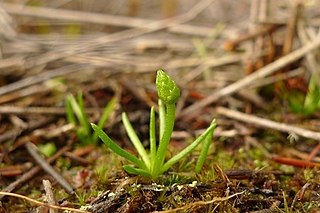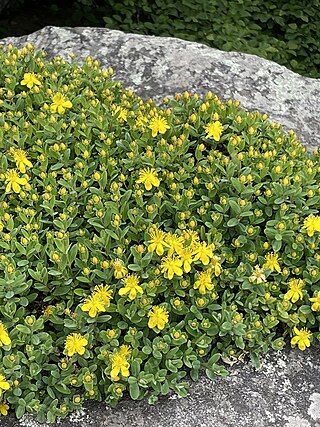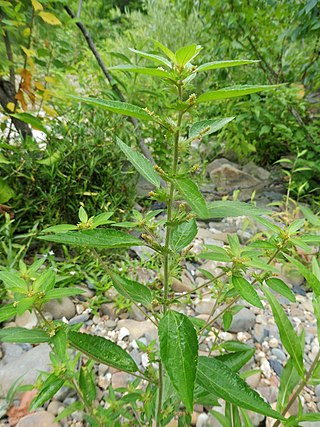
Lycopodiopsida is a class of vascular plants known as lycopods, lycophytes or other terms including the component lyco-. Members of the class are also called clubmosses, firmosses, spikemosses and quillworts. They have dichotomously branching stems bearing simple leaves called microphylls and reproduce by means of spores borne in sporangia on the sides of the stems at the bases of the leaves. Although living species are small, during the Carboniferous, extinct tree-like forms (Lepidodendrales) formed huge forests that dominated the landscape and contributed to coal deposits.

Huperzia is a genus of lycophyte plants, sometimes known as the firmosses or fir clubmosses; the Flora of North America calls them gemma fir-mosses. This genus was originally included in the related genus Lycopodium, from which it differs in having undifferentiated sporangial leaves, and the sporangia not formed into apical cones. The common name firmoss, used for some of the north temperate species, refers to their superficial resemblance to branches of fir (Abies), a conifer. As of 2020, two very different circumscriptions of the genus were in use. In the Pteridophyte Phylogeny Group classification of 2016, Huperzia is one of three genera in the subfamily Huperzioideae of the family Lycopodiaceae. Most species in the subfamily are placed in the genus Phlegmariurus. Huperzia is left with about 25 species, although not all have been formally transferred to other genera. Other sources recognize only Huperzia, which then has about 340 species.

Phylloglossum, a genus in the clubmoss family Lycopodiaceae, is a small plant superficially resembling a tiny grass plant, growing with a rosette of slender leaves 2–5 cm long from an underground bulb-like root. It has a single central stem up to 5 cm tall bearing a spore-producing cone at the apex, and was previously classified variously in the family Lycopodiaceae or in its own family the Phylloglossaceae, but recent genetic evidence demonstrates it is most closely related to the genus Huperzia and is a sister clade to the genus Phlegmariurus, which was formerly included in Huperzia.

Huperzine A is a naturally occurring sesquiterpene alkaloid compound found in the firmoss Huperzia serrata and in varying quantities in other food Huperzia species, including H. elmeri, H. carinat, and H. aqualupian. Huperzine A has been investigated as a treatment for neurological conditions such as Alzheimer's disease, but a meta-analysis of those studies concluded that they were of poor methodological quality and the findings should be interpreted with caution. Huperzine A inhibits the breakdown of the neurotransmitter acetylcholine by the enzyme acetylcholinesterase. It is commonly available over the counter as a nutrient supplement, and is marketed as a cognitive enhancer for improving memory and concentration.

Toxicodendron pubescens, commonly known as Atlantic poison oak, is an upright shrub that can grow to 1 metre (3 feet) tall. Its leaves are 15 centimetres (6 inches) long, alternate, with three leaflets on each. The leaflets are usually hairy and are variable in size and shape, but most often resemble white oak leaves; they usually turn yellow or orange in autumn. The fruit is small, round, and yellowish or greenish. It is not closely related to true oaks.

Monarda fistulosa, the wild bergamot or bee balm, is a wildflower in the mint family Lamiaceae, widespread and abundant as a native plant in much of North America. This plant, with showy summer-blooming pink to lavender flowers, is often used as a honey plant, medicinal plant, and garden ornamental. The species is quite variable, and several subspecies or varieties have been recognized within it.

Tradescantia virginiana, the Virginia spiderwort, is a species of flowering plant in the family Commelinaceae. It is the type species of Tradescantia, native to the eastern United States. It is commonly grown in many gardens and also found growing wild along roadsides and railway lines.

Tradescantia ohiensis, commonly known as bluejacket or Ohio spiderwort, is an herbaceous plant species in the genus Tradescantia native to eastern and central North America. It is the most common and widely distributed species of Tradescantia in the United States, where it can be found from Maine in the northeast, west to Minnesota, and south to Texas and Florida. It also has a very small distribution in Canada in extreme southern Ontario near Windsor.

Hydrangea serrata is a species of flowering plant in the family Hydrangeaceae, native to mountainous regions of Korea and Japan. Common names include mountain hydrangea and tea of heaven. Growing to 1.2 m (4 ft) tall and broad, it is a deciduous shrub with oval leaves and panicles of blue and pink flowers in summer and autumn (fall). It is widely cultivated as an attractive ornamental shrub throughout the world in areas with suitable climate and soil.

Iris virginica, with the common name Virginia blueflag, Virginia iris, great blue flag, or southern blue flag, is a perennial species of flowering plant in the Iridaceae (iris) family, native to central and eastern North America.

Rhododendron prunifolium, the plumleaf azalea, is a wild azalea that grows only in a few counties along the Georgia–Alabama border in the Chattahoochee River Valley. It is considered the rarest azalea in the Eastern United States. Providence Canyon is one of the most popular places to view the plumleaf azalea in the wild.
Phlegmariurus mannii, synonym Huperzia mannii, is a species of lycopod, known by the common names Mann's clubmoss and wawaeʻiole. It is endemic to Hawaii, where there are only six populations remaining. It is a federally listed endangered species of the United States.

Drymocallis glandulosa, formerly Potentilla glandulosa, known by the common names Douglas' wood beauty and sticky cinquefoil, is a plant species in the family Rosaceae.
Rhamnus serrata, the sawleaf buckthorn, is a species of plant in the family Rhamnaceae. The shrub is native to Arizona, New Mexico, eastern northern Mexico, and Texas.
Balsamorhiza serrata is a North American species of plants in the tribe Heliantheae of the family Asteraceae.

Hypericum buckleyi, known as Blue Ride St. John's wort and Buckley's St. Johnswort, is a rare species of flowering plant in the family Hypericaceae found only in the Appalachian Mountains of the southeastern United States. The species is listed in the state of Georgia (S1), South Carolina (SX), and North Carolina (S3).

Acalypha virginica, commonly called Virginia threeseed mercury or Virginia copperleaf, is a plant in the spurge family (Euphorbiaceae). It is native to the eastern United States. It is found in a variety of natural habitats, particularly in open woodlands and along riverbanks. It is a somewhat weedy species that responds positively to ecological disturbance, and can be found in degraded habitats such as agricultural fields.
Allobranchiibius huperziae is a Gram-positive and non-spore-forming species of bacteria from the family of Dermacoccaceae that has been isolated from the roots of the plant Huperzia serrata from Sichuan in China.

Symphyotrichum robynsianum is a species of flowering plant in the family Asteraceae native to northeastern North America. Common names include Robyns's aster, longleaf aster, and long-leaved aster.
















